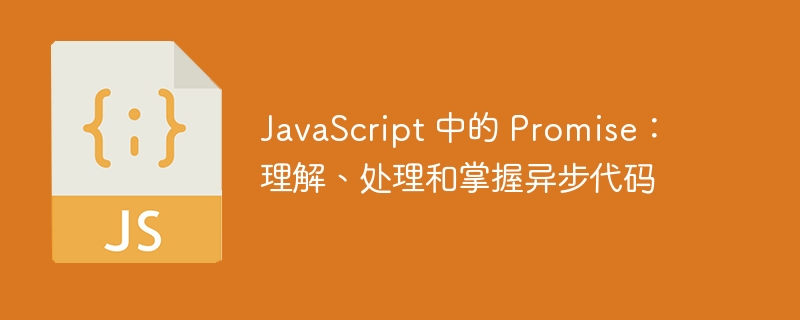JavaScript 中的 Promise:理解、处理和掌握异步代码

简介
我曾经是一名 java 开发人员,我记得第一次接触 javascript 中的 promise 时。尽管这个概念看起来很简单,但我仍然无法完全理解 promise 是如何工作的。当我开始在项目中使用它们并了解它们解决的案例时,情况发生了变化。然后灵光乍现的时刻到来了,一切都变得更加清晰了。随着时间的推移,promise 成为我工具带上的宝贵武器。当我可以在工作中使用它们并解决函数之间的异步处理时,这是一种奇怪的满足感。
您可能首先在从 api 获取数据时遇到 promise,这也是最常见的示例。最近,我接受了采访,猜猜第一个问题是什么“你能告诉我 promise 和 async await 之间的区别吗?”。我对此表示欢迎,因为我认为这是一个很好的起点,可以更好地了解申请人如何理解这些机制的运作方式。然而,他或她主要使用其他库和框架。它让我记下差异并描述处理异步函数错误的良好实践。
承诺是什么
让我们从最初的问题开始:“promise 是什么?” promise 是我们还不知道的值的占位符,但我们将通过异步计算/函数得到它。如果承诺顺利的话,我们就会得到结果。如果 promise 进展不顺利,那么 promise 将返回错误。
promise 的基本示例
定义一个承诺
通过调用 promise 的构造函数并传递两个回调函数来定义 promise:resolve 和 reject.
const newpromise = new promise((resolve, reject) => { resolve('hello'); // reject('error'); });
当我们想要成功解析 promise 时,我们调用解析函数。拒绝是在评估我们的逻辑过程中发生错误时拒绝承诺。
检索 promise 结果
我们使用内置函数 then 来获取 promise 的结果。它有两个传递的回调,结果和错误。当函数resolve成功解析promise时,将调用结果。如果 promise 未解决,则会调用第二个函数错误。该函数由拒绝或抛出的另一个错误触发。
newpromise.then(result => {
console.log(result); // hello
}, error => {
console.log("there shouldn't be an error");
});
在我们的示例中,我们将得到结果 hello,因为我们成功解决了 promise。
承诺的错误处理
当 promise 被拒绝时,总是会调用它的第二个错误回调。
const newpromise1 = new promise((resolve, reject) => { reject('an error occurred in promise1'); }); newpromise1.then( (result) => { console.log(result); // it is not invoked }, (error) => { console.log(error); // 'an error occurred in promise1' } );
为了清晰起见,更推荐的方法是使用内置的 catch 方法。
const newpromise2 = new promise((resolve, reject) => { reject('an error occurred in promise2'); }); newpromise2 .then((result) => { console.log(result); // it is not invoked }) .catch((error) => { console.log(error); // 'an error occurred in promise2' });
catch 方法是链式的,并提供了自己的错误回调。当 promise 被拒绝时它会被调用。
两个版本都运行良好,但链接在我看来更具可读性,并且在使用我们进一步介绍的其他内置方法时非常方便。
连锁承诺
一个承诺的结果可能是另一个承诺。在这种情况下,我们可以链接任意数量的 then 函数。
getjson('categories.json')
.then(categories => {
console.log('fetched categories:', categories);
return getjson(categories[0].itemsurl);
})
.then(items => {
console.log('fetched items:', items);
return getjson(items[0].detailsurl);
})
.then(details => {
console.log('fetched details:', details);
})
.catch(error => {
console.error('an error has occurred:', error.message);
});
在我们的示例中,它用于缩小搜索结果范围以获取详细数据。每个 then 函数也可以有其错误回调。如果我们只关心捕获调用链中的任何错误,那么我们可以利用 catch 函数。如果任何 promise 返回错误,它将被评估。
答应一切
有时我们想等待更独立的 promise 的结果,然后根据结果采取行动。如果我们不关心 promise 的解析顺序,我们可以使用内置函数 promise.all。
promise.all([
getjson('categories.json'),
getjson('technology_items.json'),
getjson('science_items.json')
])
.then(results => {
const categories = results[0];
const techitems = results[1];
const scienceitems = results[2];
console.log('fetched categories:', categories);
console.log('fetched technology items:', techitems);
console.log('fetched science items:', scienceitems);
// fetch details of the first item in each category
return promise.all([
getjson(techitems[0].detailsurl),
getjson(scienceitems[0].detailsurl)
]);
})
.then(detailsresults => {
const laptopdetails = detailsresults[0];
const physicsdetails = detailsresults[1];
console.log('fetched laptop details:', laptopdetails);
console.log('fetched physics details:', physicsdetails);
})
.catch(error => {
console.error('an error has occurred:', error.message);
});
promise.all 接受 promise 数组并返回结果数组。如果 promise 之一被拒绝,则 promise.all 也会被拒绝。
赛车承诺
另一个内置功能是 promise.race。当您有多个异步函数(promise)并且您想要对它们进行竞赛时,可以使用它。
promise.race([
getjson('technology_items.json'),
getjson('science_items.json')
])
.then(result => {
console.log('first resolved data:', result);
})
.catch(error => {
console.error('an error has occurred:', error.message);
});
promise 的执行可能需要不同的时间,promise.race 会评估数组中第一个已解决或拒绝的 promise。当我们不关心顺序但我们想要最快的异步调用的结果时使用它。
什么是异步等待
如您所见,编写 promise 需要大量样板代码。幸运的是,我们有原生的 async await 功能,这使得使用 promises 变得更加容易。我们用“async”这个词来标记一个函数,并且通过它,我们说在代码中的某个地方我们将调用异步函数,我们不应该等待它。然后使用await 字调用异步函数。
异步等待的基本示例
const fetchdata = async () => {
try {
// fetch the categories
const categories = await getjson('categories.json');
console.log('fetched categories:', categories);
// fetch items from the first category (technology)
const techitems = await getjson(categories[0].itemsurl);
console.log('fetched technology items:', techitems);
// fetch details of the first item in technology (laptops)
const laptopdetails = await getjson(techitems[0].detailsurl);
console.log('fetched laptop details:', laptopdetails);
} catch (error) {
console.error('an error has occurred:', error.message);
}
};
fetchdata();
我们的 fetchdata 被标记为异步,它允许我们使用await 来处理函数内的异步调用。我们调用更多的 promise,它们会一个接一个地进行评估。
如果我们想处理错误,我们可以使用 try...catch 块。然后被拒绝的错误被捕获在 catch 块中,我们可以像记录错误一样对其采取行动。
有什么不同
它们都是 javascript 处理异步代码的功能。主要区别在于 promise 使用 then 和 catch 链接时的语法,但 async wait 语法更多地采用同步方式。它使它更容易阅读。当异步等待利用 try...catch 块时,错误处理更加简单。这是面试时很容易被问到的问题。在回答过程中,您可以更深入地了解两者的描述并突出显示这些差异。
承诺功能
当然,您可以通过 async wait 使用所有功能。例如 promise.all。
const fetchalldata = async () => {
try {
// use await with promise.all to fetch multiple json files in parallel
const [techitems, scienceitems, laptopdetails] = await promise.all([
getjson('technology_items.json'),
getjson('science_items.json'),
getjson('laptops_details.json')
]);
console.log('fetched technology items:', techitems);
console.log('fetched science items:', scienceitems);
console.log('fetched laptop details:', laptopdetails);
} catch (error) {
console.error('an error occurred:', error.message);
}
};
实际用例
promise 是 javascript 中用于处理异步代码的基本功能。主要使用方法如下:
从 api 获取数据
如上面的示例所示,这是 promise 最常用的用例之一,您每天都会使用它。
处理文件操作
可以使用 promise 来异步读写文件,特别是通过 node.js 模块 fs.promises
import * as fs from 'fs/promises';
const writeFileAsync = async (filePath, content, options = {}) => {
try {
await fs.writeFile(filePath, content, options);
console.log(`File successfully written to ${filePath}`);
} catch (error) {
console.error(`Error writing file to ${filePath}:`, error.message);
}
};
const filePath = 'output.txt';
const fileContent = 'Hello, this is some content to write to the file!';
const fileOptions = { encoding: 'utf8', flag: 'w' }; // Optional file write options
writeFileAsync(filePath, fileContent, fileOptions);
基于 promise 的库
axios 是你应该熟悉的库。 axios 在客户端处理 http 请求,使用广泛。
express 是 node.js 的 web 框架。它使构建 web 应用程序和 api 变得容易,并且当您将 promise 与 express 结合使用时,您的代码将保持干净且易于管理。
带有示例的存储库
所有示例都可以在:https://github.com/princam/promise-example
概括
promise 是 javascript 的基本组成部分,对于处理 web 开发中的异步任务至关重要。无论是获取数据、处理文件还是使用 axios 和 express 等流行库,您都会经常在代码中使用 promise。
在本文中,我们探讨了 promise 是什么、如何定义和检索其结果以及如何有效地处理错误。我们还介绍了链接、promise.all 和 promise.race 等关键功能。最后,我们引入了 async wait 语法,它提供了一种更直接的方式来使用 promise。
理解这些概念对于任何 javascript 开发人员来说都至关重要,因为它们是您日常依赖的工具。
如果您还没有尝试过,我建议您编写一个简单的代码片段来从 api 获取数据。您可以从一个有趣的 api 开始进行试验。另外,此存储库中提供了所有示例和代码片段供您探索。
以上就是JavaScript 中的 Promise:理解、处理和掌握异步代码的详细内容,更多请关注www.sxiaw.com其它相关文章!
